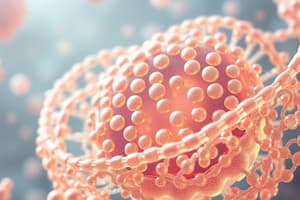Podcast
Questions and Answers
What misconception was corrected regarding the composition of cell membranes?
What misconception was corrected regarding the composition of cell membranes?
- They consist of four layers.
- They consist only of one layer.
- They consist of two layers. (correct)
- They consist of three layers.
What characteristic of the phospholipids contributes to the cell membrane's structure?
What characteristic of the phospholipids contributes to the cell membrane's structure?
- The tails are hydrophilic and heads are non-polar.
- All components are saturated.
- The heads are polar and the tails are non-polar. (correct)
- Both the heads and tails are hydrophilic.
Why can't polar substances easily diffuse through the cell membrane?
Why can't polar substances easily diffuse through the cell membrane?
- The inner layer of the membrane is hydrophobic. (correct)
- The membrane consists of only non-polar substances.
- The membrane is completely impermeable.
- The membrane favors the diffusion of small ions only.
What role do sodium ions play in the cell's structure?
What role do sodium ions play in the cell's structure?
What challenge does a simple lipid bilayer present in terms of cellular function?
What challenge does a simple lipid bilayer present in terms of cellular function?
What distinguishes transmembrane proteins from other types of membrane proteins?
What distinguishes transmembrane proteins from other types of membrane proteins?
Which of the following accurately describes the role of sodium pumps in cells?
Which of the following accurately describes the role of sodium pumps in cells?
How do calcium channels differ from calcium pumps in membrane transport?
How do calcium channels differ from calcium pumps in membrane transport?
What is the primary function of glycoproteins and glycolipids found in cell membranes?
What is the primary function of glycoproteins and glycolipids found in cell membranes?
What happens to cell membrane flexibility as the amount of cholesterol increases?
What happens to cell membrane flexibility as the amount of cholesterol increases?
Flashcards are hidden until you start studying
Study Notes
Surface of the Cell
- Initially described as trilaminar (three layers), later corrected to bilayer due to reevaluation.
- Cell membranes consist mainly of lipids, forming a lipid bilayer.
Composition of the Cell Membrane
- Comprised predominantly of phospholipids.
- Phospholipids feature a polar head (glycerol and phosphate) and non-polar tails (unsaturated fatty acids).
- Polar heads face outward while non-polar tails orient inward, creating distinct internal and external environments.
Membrane Environment
- Internal membrane environment is non-polar and hydrophobic, while the external surface is polar and hydrophilic.
- Polar substances cannot easily diffuse through the membrane, necessitating controlled movement.
- Sodium ions present significant concentration differences: low inside the cell and high outside, maintaining the cell's polar nature.
Membrane Functionality
- The lipid bilayer serves as a selective barrier for substances, but is enhanced by embedded proteins.
- Specialized proteins in the bilayer facilitate the movement of large and polar molecules, enhancing membrane functionality.
Cell Specialization
- Cell membranes reflect the specific needs of the cell’s function (e.g., liver cells vs. red blood cells).
Integral and Transmembrane Proteins
- Transmembrane proteins span the lipid bilayer, protruding from both sides.
- These proteins can function interchangeably with integral proteins.
Classification of Transmembrane Proteins
- Pumps: Maintain specific concentrations using ATP (e.g., sodium pumps).
- Channels: Allow ions/molecules passage along concentration gradients without ATP (e.g., calcium channels).
- Gap Junctions: Facilitate fast ion signaling between adjacent cells.
- Receptors: Bind ligands to elicit cellular responses, often triggering the secretion of hormones.
Other Membrane-Bound Structures
- Glycoproteins and Glycolipids: Carbohydrate-associated proteins/lipids found on extracellular vesicles, contributing to cell-cell recognition.
- Cholesterol: Present in all cell membranes, enhances rigidity while reducing flexibility; higher cholesterol lowers membrane fluidity.
- Cell Coat (Glycocalyx): A glycoprotein and glycolipid covering that surrounds cell membranes, allowing for enzyme secretion.
Studying That Suits You
Use AI to generate personalized quizzes and flashcards to suit your learning preferences.




